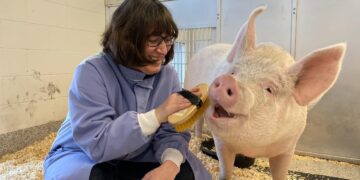Table of Contents
Introduction: The Ghost of a Good Dog
There are ghosts in animal shelters.
They aren’t the spirits of the animals we’ve lost; they are the ghosts of the good dogs who were returned.
I’ve been a director and manager in animal welfare for over two decades, overseeing everything from intake and behavioral assessments to the final, hopeful handshake of an adoption.1
And of all the ghosts that walk the halls of my memory, the one that haunts me most is a brindle mutt named Bruno.
Bruno was, by every metric we had, a perfect dog.
He was a two-year-old mix of something sturdy and something sweet.
He was gentle with children, indifferent to cats, and had a soft, intelligent gaze that suggested an old soul.
He aced his temperament tests and walked politely on a leash.
When a lovely family—two parents, two kids, a fenced yard—came looking for their first dog, Bruno was the obvious choice.
It felt like a storybook ending.
Less than a month later, they brought him back.
The father wouldn’t meet my eyes.
The mother was in tears.
Bruno, they said, had developed “issues.” He was destructive when left alone, chewing on doorframes.
He had started barking incessantly at neighbors.
He was, they concluded with heartbreaking finality, “not the right fit.” As I led Bruno back to a sterile kennel, the light in his eyes seemed dimmer.
He was the same good dog, but now he was branded with the stigma of failure.
Their failure, and mine.
That day, I was confronted with the question that would define my career: Why do good matches fail? We had followed all the rules.
We checked all the boxes.
Yet the result was a traumatized dog and a devastated family.
The experience forced me to question everything I thought I knew about matching dogs with people.
It sent me on a years-long search for a better way, a journey that led me to a conclusion that still feels radical today: the question “What is the best house dog?” is fundamentally flawed.
It’s the wrong question entirely.
The real question, the one that unlocks the secret to a successful, lifelong bond, is this: “What kind of system is my house, and what role is available within it?”
This report is the culmination of that journey.
I will show you that a successful adoption is not about finding the “best” dog; it’s about becoming an “architect” of your family system and “casting” a dog for a role it is naturally suited to fill.
We will dismantle the old myths that lead to heartbreak and build a new, systems-based framework for success.
The heartbreak of a returned dog isn’t just an emotional event; it’s a data point indicating a systemic failure.
The failure isn’t in the dog or the family in isolation, but in the interface between them.
The conventional adoption process completely ignores this interface.
Together, we will learn to see it, understand it, and design it for a love that lasts a lifetime.
In a Nutshell: The Systems-Thinking Shift
For those seeking immediate clarity, here is the core paradigm shift this report offers:
- The Old Way (The Mismatch Model): Focuses on the dog’s isolated traits (breed, looks, shelter behavior). This approach is self-centered, asking, “What do I want from a dog?” It leads to unrealistic expectations and a high failure rate when the dog’s reality doesn’t match the adopter’s fantasy.
- The New Way (The Systems-Casting Model): Focuses on the adopter’s household as a unique ecosystem. This approach is diagnostic, asking, “What are the needs of my home’s ecosystem, and what kind of dog has the innate traits to thrive here?” It replaces guesswork with a clear, four-step process:
- Audit Your Ecosystem: Deeply analyze your home’s energy, social landscape, routines, and stress patterns.
- Write the Role Description: Create a specific “casting call” that defines the behavioral traits a dog needs to succeed in your system.
- Hold an Audition: Use targeted questions and observations to assess potential dogs against your role description.
- Manage the Onboarding: Follow a structured 90-day plan to integrate the dog, manage expectations, and build a foundation of trust.
This shift moves you from being a hopeful consumer picking a product to a thoughtful architect designing a successful, integrated family.
Chapter 1: The Great Mismatch: Deconstructing the Myths of Dog Selection
Before we can build a new model, we must first demolish the old, faulty one.
My experience with Bruno was a painful lesson that the standard methods of choosing a dog are built on a foundation of sand.
They are rooted in a series of myths that prioritize human desires over a diagnostic assessment of mutual compatibility.
This self-centered approach is the root cause of what I call the “Great Mismatch”—the gap between the dog we think we are getting and the dog we actually bring home.
This gap is where heartbreak lives.
Let’s examine the three most pervasive myths.
The Breed Checklist Fallacy
The most common starting point for prospective adopters is the breed.
People arrive at the shelter with a checklist in mind: “We want a Labrador because they’re good with kids,” or “We need a Poodle mix because they don’t shed.” While breed can provide a general blueprint for size, coat, and certain energy tendencies, relying on it as a primary selection tool is a profound mistake.4
This approach fails because it ignores two crucial factors: individual variation and life experience.
Within any given breed, there is a vast spectrum of temperaments.
I have met shy, retiring Golden Retrievers and couch-potato Border Collies.
Genetics is a lottery, and a dog’s personality is shaped as much by its unique neurological wiring and early life experiences as it is by its breed standard.
A “family-friendly” breed that spent its first six months in a neglectful situation may develop resource guarding or fear-based behaviors that make it wholly unsuitable for a home with children.6
Furthermore, the vast majority of dogs in shelters are mixed breeds.
Their genetic heritage is a beautiful mystery.
To project the traits of one identifiable breed onto a dog that is a blend of four or five is pure fiction.
The result of this fallacy is a cascade of unmet expectations.
When the “calm” Bulldog turns out to be a bundle of anxious energy or the “biddable” Shepherd mix proves to be stubbornly independent, the adopter feels betrayed by the breed label.
The dog is then blamed for failing to live up to a stereotype it never asked for, a primary reason they are returned for being “disobedient” or “hyperactive”.8
The Pretty Face Fallacy (The Visual Veto)
Perhaps the most powerful and dangerous myth is the one driven by pure emotion: choosing a dog based on its appearance.
We are visual creatures, and the pull of a scruffy face, soulful eyes, or a unique coat color can be overwhelming.
It’s a mistake I’ve seen countless times: a family walks past dozens of suitable dogs to fixate on the one that looks like a movie star, regardless of its actual temperament.10
This is the riskiest path because it creates the widest possible chasm between the adopter’s aesthetic fantasy and the dog’s behavioral reality.
A classic example is the novice owner living in a small apartment who falls in love with a stunningly beautiful Australian Shepherd or Belgian Malinois.
They see a magnificent companion; they do not see the genetic programming for herding, the intense need for a job, and the high drive that, if unmet, will almost certainly manifest as destructive behavior, anxiety, and neuroticism.11
When that beautiful dog chews through a sofa out of sheer boredom and under-stimulation, the owner doesn’t see a systems failure—a high-energy dog in a low-energy environment.
They see a “bad dog” that has ruined their home.
The return paperwork will cite “destructive behaviors,” but the true cause was a selection process that prioritized looks over lifestyle compatibility.8
Choosing a dog is not like choosing a painting for your wall; you are choosing a dynamic, living being whose needs must be M.T. Ignoring those needs in favor of a pretty face is a recipe for mutual misery.
The 15-Minute “Connection” Myth
The final myth is the belief that you can accurately assess a dog’s true personality during a brief meet-and-greet in a shelter.
Adopters often speak of looking for an “instant connection” or a “spark.” While that feeling is wonderful, it is an entirely unreliable predictor of long-term success.
A shelter is a profoundly unnatural and stressful environment.
The constant noise, unfamiliar smells, and lack of routine can push even the most stable dog to its psychological limit.10
In response to this stress, dogs adopt one of two survival personas.
Some become hyper-aroused: barking, jumping, and spinning in their kennels.
Adopters often label them “too energetic” or “crazy.” Others shut down completely: they retreat to the back of the kennel, cowering and avoiding eye contact.
These dogs are often dismissed as “too shy,” “fearful,” or “broken.”
Neither of these personas represents the real dog.
They represent a dog in survival mode.
I have personally witnessed dogs who were frantic maniacs in their kennels transform into placid, gentle companions the moment they entered a quiet home.
I’ve also seen the “shy” dog in the corner blossom into a confident, playful extrovert once removed from the shelter’s overwhelming environment.13
The dog you meet in the shelter is often just a shadow of the dog they will become in your home.
Basing a lifelong commitment on that 15-minute snapshot is like judging a person’s entire character based on how they act while their house is on fire.
It ignores the critical context and leads to profound misunderstandings about the dog’s true nature.
These three myths, born from a desire for a simple, gratifying selection process, are the architects of failure.
They encourage a fundamentally flawed, one-sided perspective that places the burden of success entirely on the dog.
To find a better way, we must shift our focus from the dog in isolation to the complex world it is about to enter: our home.
Chapter 2: The Systems Epiphany: Your Home is an Ecosystem, Not a Stage
The ghost of Bruno followed me for months.
I replayed the adoption, the return, every detail, searching for the error.
The family wasn’t malicious, and Bruno wasn’t a “bad dog.” So what went wrong? The answer didn’t come from any animal behavior textbook.
It came, unexpectedly, from the world of human psychology.
While researching family conflict, I stumbled upon the work of psychiatrist Murray Bowen and his Family Systems Theory.
It was like a lightning bolt.
For the first time, I had a framework that explained the invisible forces that had torn that adoption apart.
Bowen’s revolutionary idea was that a family is not a collection of individuals, but a single “emotional unit”.14
The members are so deeply interconnected that they function as if under one “emotional skin.” A change in one member’s functioning is predictably followed by reciprocal changes in the others.
Reading this, I realized my mistake.
I had been treating the adoption like a transaction, placing an object (the dog) into a container (the family).
But a dog doesn’t just enter a house; it enters an invisible, highly reactive emotional Web.
This epiphany transformed my entire approach.
I stopped being a matchmaker and started thinking like a systems analyst.
I began to see that every home is a unique ecosystem with its own climate, rules, and delicate balance.
A new dog isn’t just an addition; it’s a major environmental event, a “perturbation” that disrupts the system’s balance, or “homeostasis”.15
The stress that follows—the “adopter’s remorse” so many people feel—isn’t just the new owner’s anxiety; it’s the entire system groaning as it struggles to find a new equilibrium.16
The Dog as a Symptom-Bearer
The most powerful concept I borrowed from systems thinking was the idea of the “symptom-bearer.” In a human family under stress, one member—often a child—will absorb the ambient anxiety and begin to display “problem” behaviors.14
This allows the family to focus on “fixing” the symptomatic person instead of addressing the root dysfunction in the system itself.
I realized this was happening constantly in failed adoptions.
A dog, being non-verbal and exquisitely sensitive to emotional currents, is the perfect candidate to become the symptom-bearer for a household’s pre-existing, unacknowledged stress.
Consider a couple experiencing quiet marital tension.
They decide to get a dog, hoping it will be a joyful distraction or a source of shared purpose.
The dog enters the home and immediately senses the simmering anxiety.
It doesn’t understand the cause, but it feels the emotional charge in the air.
In response, it develops severe separation anxiety, howling and shredding the blinds whenever left alone.9
The couple now has a new, tangible problem to focus on: “the dog’s anxiety.” They argue about training methods, vet bills, and who forgot to crate him.
They pour all their frustration into the dog’s behavior, which conveniently allows them to ignore the marital decay that was the true source of the system’s anxiety.
The dog’s “problem behavior” is not a flaw in the dog; it is a symptom of a flaw in the system.
This reframes the entire narrative of adoption failure.
The barking, the destruction, the aggression—these are not necessarily signs of a “bad dog.” They are often signals, a desperate communication from a sensitive creature that has been cast into a role it is not equipped to play within a system that is already unstable.
The question is no longer, “How do we fix this dog?” but rather, “What is our home’s ecosystem telling us through this dog?” This is the beginning of a more honest, more effective, and more compassionate way to think about creating a family with a dog.
Chapter 3: The Four Pillars of “Systems-Based Casting”
Understanding your home as an ecosystem is the philosophical shift.
Now, we need a practical method to apply it.
If your home is a stage, you are the casting director.
Your job is not to find the most beautiful or famous actor, but the right actor for the part.
This requires a rigorous, four-step process I call “Systems-Based Casting.” It moves the selection process from an emotional impulse to a thoughtful, diagnostic strategy.
Pillar I: Auditing Your Ecosystem (Writing the Script)
Before you can cast a role, you must understand the play.
The first step is to conduct a brutally honest audit of your household’s ecosystem.
This isn’t about what you wish your home was like; it’s about what it is like, day in and day O.T. You must become an anthropologist of your own life.
Here are the key areas to analyze:
- Energy & Pace: Is your home a quiet library or a bustling train station? Is the baseline sound level a gentle hum or a chaotic symphony of televisions, video games, and loud conversations? A dog with a sensitive, sound-reactive nature will be in a constant state of high alert in a loud, busy home, while a dog that thrives on activity may become bored and destructive in a home that is too quiet and sedate.4
- Social Landscape: Who lives in your home, and what are their temperaments? Do you have young, unpredictable children? Stoic teenagers? An elderly parent with mobility issues? Do you have other pets, and what is their history with other animals? How often do you have guests? Is your front door a revolving one, or do you rarely entertain? The social demands of your home are a primary factor in determining the kind of dog that can succeed there.19
- Routine & Predictability: Map out a typical weekday and weekend. What time do you wake up? What time do you leave for work or school? Crucially, how many consecutive hours will the dog be left alone? Is your schedule consistent, or does it change week to week? Dogs are creatures of habit; they thrive on predictability. A highly variable schedule can be a major source of stress for many dogs, often leading to separation anxiety.19
- Conflict & Stress Style: This is the most difficult but most important part of the audit. How does your family handle stress? When there’s a disagreement, does the volume in the house go up, with loud arguments and slammed doors? Or does it go down, with icy silence and passive aggression? A dog in either environment will absorb that emotional energy. A dog that is naturally anxious will be shattered by overt conflict, while a more stoic dog might be better able to weather it. Be honest about the emotional climate of your home.
Pillar II: Writing the Role Description (The Casting Call)
Once you have a clear, objective script of your life, you can write the casting call.
This is where you translate the realities of your ecosystem into a specific list of required canine behavioral traits.
You are moving beyond vague desires like “friendly” and into a concrete, functional job description.
This is the critical bridge between self-reflection and practical action.
It forces you to stop thinking about what you want a dog to look like and start defining what you need a dog to be like to maintain the health of your ecosystem.
The following matrix is the tool I developed to make this translation systematic.
It connects a tangible reality of your household to a required, observable canine behavior.
This transforms the search from a vague, emotion-driven process into a clear, data-driven one.
Instead of going to the shelter to “see who they have,” you go with a specific behavioral profile to screen for, dramatically increasing the odds of a successful match.
Table 1: The Ecosystem-to-Canine Casting Matrix
| Your Household Ecosystem Trait | Corresponding Canine ‘Role’ Requirement |
| High-traffic home with frequent, unpredictable visitors and young children. | Low Territoriality: Does not resource guard space, toys, or people. Rapid Social Recovery: Bounces back quickly from startling events (e.g., a dropped pot, a child’s shriek). High Bite Inhibition: Has a naturally soft mouth; tolerant of clumsy handling. |
| Quiet, predictable home with a single adult who works 9-hour days. | High Capacity for Independence: Not prone to separation anxiety; can self-soothe and settle alone. Low to Moderate Energy: Content with one long walk/play session per day. Low Barking Propensity: Not a constitutional alarm barker. |
| Active couple, avid hikers, living in an apartment with another dog. | High Energy & Stamina: Physically sound and built for long-distance activity. Dog Social/Tolerant: Has a proven positive history with other dogs; not easily offended by normal dog-dog interactions. Low Reactivity in Urban Environments: Not easily overstimulated by city sounds, traffic, and crowds. |
| Home with an elderly person and a resident cat. | Low Physical Impulsivity: Not prone to jumping up or boisterous play that could knock someone over. Low Prey Drive: Has a demonstrated history of coexisting safely with cats or shows no interest. High Cuddle Drive: Seeks out calm, physical affection. |
Your own role description will be a unique combination of these and other traits.
The goal is to create a detailed profile of the temperament, energy level, and social skills of the dog that is already, by its very nature, poised to succeed in the specific environment you can provide.
Pillar III: The Audition Process (Screen Tests)
Armed with your detailed role description, you are now ready to begin the audition process.
This is no longer a search for a “spark”; it’s a methodical assessment.
First, you must partner with the experts on the ground: the shelter staff, rescue volunteers, or foster parents.1
These individuals have spent days, weeks, or even months with these dogs and are your single most valuable source of information.10
Do not start by asking to see a specific dog.
Start by sharing your role description.
Say, “This is a detailed picture of my home and the type of dog that would thrive there.
Do you have any animals in your care who you think might fit this role?” This reframes the conversation from sales to consultation.
Ask specific, behavioral questions that relate directly to your casting call:
- Instead of “Is he friendly?” ask, “How does he react when a stranger enters his space? What is his recovery time after being startled?”
- Instead of “Is he high-energy?” ask, “When he’s had a long walk, can he settle in the house, or is he still looking for something to do?”
- Instead of “Is he good with other dogs?” ask, “Can you describe his play style? Is he a rough-and-tumble wrestler or a gentle chaser? How does he react to another dog taking his toy?”
- Crucially, ask about the dog’s history, if known, and its behavior in a previous home or foster environment. A dog’s behavior in a home setting is far more predictive than its behavior in a shelter kennel.10
When you do meet a potential candidate, observe them in various contexts.
Ask to see the dog in a quiet office away from the noisy kennel floor.
Take them to a secure outdoor yard.
If possible, take them for a walk in a semi-busy area.
Watch how they respond to the world.
Are they curious or fearful? Do they solicit attention or shy away? Does a loud noise send them into a panic, or do they look to you for guidance and recover quickly? This is not about running through a checklist of commands; it’s about observing the dog’s fundamental nature and seeing how closely it aligns with the role you need to fill.
Pillar IV: The Onboarding Protocol (The Rehearsal Period)
Casting the right actor is only half the battle.
The most brilliant performer can fail if they are thrown on stage without any rehearsal.
The first 90 days after adoption are a critical onboarding and integration period for both the dog and your family’s ecosystem.
Rushing this process or having unrealistic expectations is a primary driver of adoption failure.10
The most effective framework for managing this period is the “Rule of Threes”: 3 days, 3 weeks, 3 months.17
- The First 3 Days: Decompression. During this period, your new dog will be overwhelmed. Their entire world has changed. Your only goal is to make them feel safe. Keep the environment calm and predictable. Do not invite friends and family over to meet the new dog. Do not take them to a busy pet store or dog park. Focus on the basics: regular, leashed potty breaks; quiet time in a crate or designated safe space; and minimal pressure to interact. They may not eat much, they may hide, and they may have accidents. This is normal. Your job is to be a calm, stable presence, not an entertainment director.17
- The First 3 Weeks: Routine Building. By now, your dog is starting to settle in and learn the rhythms of your home. This is when their true personality begins to emerge. It is also when “problem” behaviors may first appear as they test boundaries and figure out the rules. This is the most crucial time to establish a consistent daily routine for feeding, walking, training, and sleeping. Consistency builds security and predictability, which are the antidotes to anxiety. This is the time to start short, positive training sessions to build your bond and establish clear communication.17
- The First 3 Months: Integration and Bonding. After three months, most dogs finally feel at home. The routines are established, trust has been built, and a real bond has formed. Your dog understands they are a permanent member of the family. This is the point where you can begin to expand their world more, introducing them to new people and situations with confidence. The hard work of the first few weeks pays off here, creating a foundation for a lifetime of companionship. This patient, structured approach directly counters the myth of the “instant best friend” and acknowledges the reality that building a deep, resilient relationship takes time.10
Conclusion: From Adopter to Architect
For years, the conventional wisdom in animal adoption has been to focus on the animal—its breed, its looks, its history.
We have operated under the assumption that if we could just find the “right dog,” everything else would fall into place.
My journey, which began with the ghost of a good dog named Bruno, has taught me that this approach is fundamentally backward.
The secret to a successful adoption lies not in finding the perfect dog, but in first understanding the world you are asking that dog to join.
You are not merely adopting a pet; you are consciously redesigning your family’s ecosystem.
The goal is not to find a “good dog,” but to create an environment where a dog can be good.
This requires a shift in identity—from a passive consumer hoping for a good match to an active, thoughtful architect who designs one.
Which brings me back to Bruno.
After his heartbreaking return, I set aside our old checklists.
I stopped looking at him as a collection of traits and started thinking about the kind of system in which he would thrive.
His file noted destruction and barking when left alone, which told me he needed a home with near-constant human presence.
His gentle, quiet nature suggested he would do best in a low-energy, predictable environment.
I wrote a new “role description” for him: a companion for a calm, home-based individual or couple, in a house with minimal social traffic and a highly predictable routine.
A few weeks later, a retired widower came to the shelter.
His children were grown, his house was quiet, and he was lonely.
He wasn’t looking for a hiking buddy or a watchdog; he was looking for a steady, quiet presence to share his days.
He didn’t care about breed or looks.
I introduced him to Bruno.
It wasn’t a moment of explosive, cinematic joy.
It was a moment of quiet, mutual recognition.
Bruno leaned his body against the man’s leg, and the man simply rested his hand on Bruno’s head.
It was a perfect fit, not because of a spark, but because of a systemic compatibility.
I placed Bruno in that home, and they were inseparable for the next nine years, until Bruno passed away peacefully in his sleep, lying next to the man’s bed.
Bruno’s story is the proof.
Success is not a matter of luck; it is a matter of design.
By auditing your ecosystem, writing a clear role description, auditioning candidates with rigor, and managing the onboarding process with patience, you transform the odds.
You leave nothing to chance.
You step into your power not as a mere adopter, but as the architect of your own happy, whole, and resilient family.
Works cited
- 1 Paws4ever Adoption Center Adoption Coordinator Job Description Position Summary, accessed August 16, 2025, https://paws4ever.org/wp-content/uploads/2021/06/Adoption-Coordinator_job-description_9.25.2020.pdf
- Intake and Admission Director Job Description 7/2024 Role: Director of Intake and Adoption Our mission is to advocate for animal – Quincy Animal Shelter, accessed August 16, 2025, https://www.quincyanimalshelter.org/wp-content/uploads/2024/07/JOB-POSTING-DIRECTOR-INTAKE-AND-ADOPTION-2024.pdf
- ANIMAL SHELTER MANAGER – Newport News, accessed August 16, 2025, https://www.nnva.gov/DocumentCenter/View/2878/Animal-Shelter-Manager-PRT-Animal-Services
- Find the Right Dog for You: Picking a Canine Friend – HelpGuide.org, accessed August 16, 2025, https://www.helpguide.org/wellness/pets/choosing-the-right-dog
- The Best Dog Breed for Your Personality and Lifestyle | Veterinarian in Huber Heights, OH, accessed August 16, 2025, https://www.oldtroypikevetclinic.com/articles/731261-the-best-dog-breed-for-your-personality-and-lifestyle
- Canine Rehoming Failure Rate: Why Returns Happen & How to Help | Pets4Homes, accessed August 16, 2025, https://www.pets4homes.co.uk/pet-advice/canine-rehoming-and-its-failure-rate.html
- Why have you chosen NOT to adopt? : r/dogs – Reddit, accessed August 16, 2025, https://www.reddit.com/r/dogs/comments/wb55ol/why_have_you_chosen_not_to_adopt/
- Reasons Why Dogs Are Returned After Adoption – Hill’s Pet Nutrition, accessed August 16, 2025, https://www.hillspet.com/dog-care/new-pet-parent/common-reasons-adopted-dogs-are-returned-to-shelters
- Factors Informing the Return of Adopted Dogs and Cats to an Animal Shelter – PMC, accessed August 16, 2025, https://pmc.ncbi.nlm.nih.gov/articles/PMC7552273/
- 10 Dog Adoption Mistakes – Great Pet Living, accessed August 16, 2025, https://living.greatpetcare.com/inspiration/dog-adoption-mistakes/
- When a Dog Adoption Doesn’t Work Out • Free Wheelin’, accessed August 16, 2025, https://www.freewheelintravel.org/when-a-dog-adoption-doesnt-work-out/
- 7 Ridiculous Reasons Dogs Were Returned to Shelters—You’ll Be Furious! – Rocky Kanaka, accessed August 16, 2025, https://rockykanaka.com/7-ridiculous-reasons-dogs-were-returned-to-shelters-youll-be-furious/
- After a Failed Foster, She Feared Adopting Again. But a Shy Puppy Helped Her Get Over Her Fears (Exclusive) – People.com, accessed August 16, 2025, https://people.com/she-went-to-the-shelter-just-to-look-then-a-shy-puppy-changed-everything-exclusive-11784251
- Introduction to the Eight Concepts — The Bowen Center for the …, accessed August 16, 2025, https://www.thebowencenter.org/introduction-eight-concepts
- Systemic Thinking in Couple and Family Psychology Research and Practice, accessed August 16, 2025, https://www.apa.org/pubs/journals/features/cfp-1-1-14.pdf
- Adoption regret : r/Pets – Reddit, accessed August 16, 2025, https://www.reddit.com/r/Pets/comments/1l5au9g/adoption_regret/
- What is Adopter’s Remorse? – Dane County Humane Society, accessed August 16, 2025, https://www.giveshelter.org/news/what-is-adopters-remorse
- I failed as a first time adopter : r/dogs – Reddit, accessed August 16, 2025, https://www.reddit.com/r/dogs/comments/129btig/i_failed_as_a_first_time_adopter/
- Picking the Right Dog for Your Lifestyle – PAWS, accessed August 16, 2025, https://www.paws.org/resources/picking-the-right-dog-for-your-lifestyle/
- IAMS Dog Breed Selector Quiz – What’s the Best Dog Breed for Me?, accessed August 16, 2025, https://www.iams.com/dog-breed-selector






